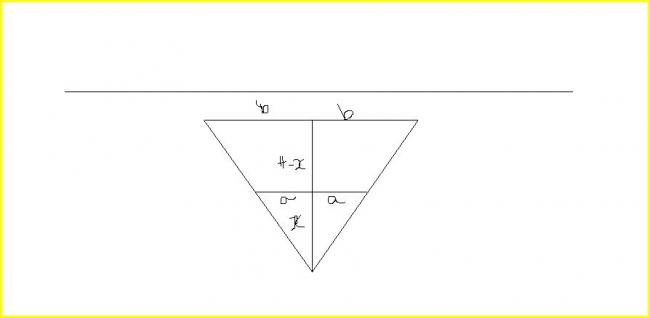ok got it wait posting soln
a triangle is immersed in a liquid with its base towards the surface.
how must we divide the triangle into two parts by a straight horizontal line such that equal thrust acts on the parts ?
-
UP 0 DOWN 0 0 11

11 Answers

let the triangle be divided at a distance x from its vertex
let the base length =2b
and the base length of the triangle fromed by the horizontal line = 2a
now we know that buoyant force just depends on the volume(in this case area )
of submerged portion
thus the horizontal line will divide those two parts by equal area
area of trapezium = bH-ax
area of triangle formed = ax
hence bH-ax=ax
but
a/b=x/H
hence a=bx/H
thus x=
H/√2
one thing
her i have taken the triangle to be isoceles(to type less)
but if for general then use the above method (just that then you need to consider the whole side)and you will get the answer
rohan m sorry but why do you think that the horizontal line will cut the triangle into two parts with equal area ??... and are u sure thrust has anything to do with the buoyancy ?
... guess thrust is due to the pressure of the liquid which is contained in the vessel !!
have u forgotten that buoyancy comes from pressure of liquid ..
and buoyant force and thrust are the same..
rohan !!... thrust acts even on the lateral and bottom surface perpendicular to it.. whereas buoyancy has only upward direction !!... thrust is due to the liquid which is contained in a vessel or similar to that !................. anyway, the answer is wrong yar !
plz give the figure then !!
most probably i understood the problem wrongly
..
but one thing
buoyant force and thrust are the same !!
thrust and buoyant force are both result of the force exerted by water ...
and anyway as the body is not moving in the horizontal direction ,,
the net force due to water must be upwards :)
so buoyant force an thrust are the same
dont get confused with both
ok yarr but in this very case the thrust is acting horizontally on the vertical plane na ?